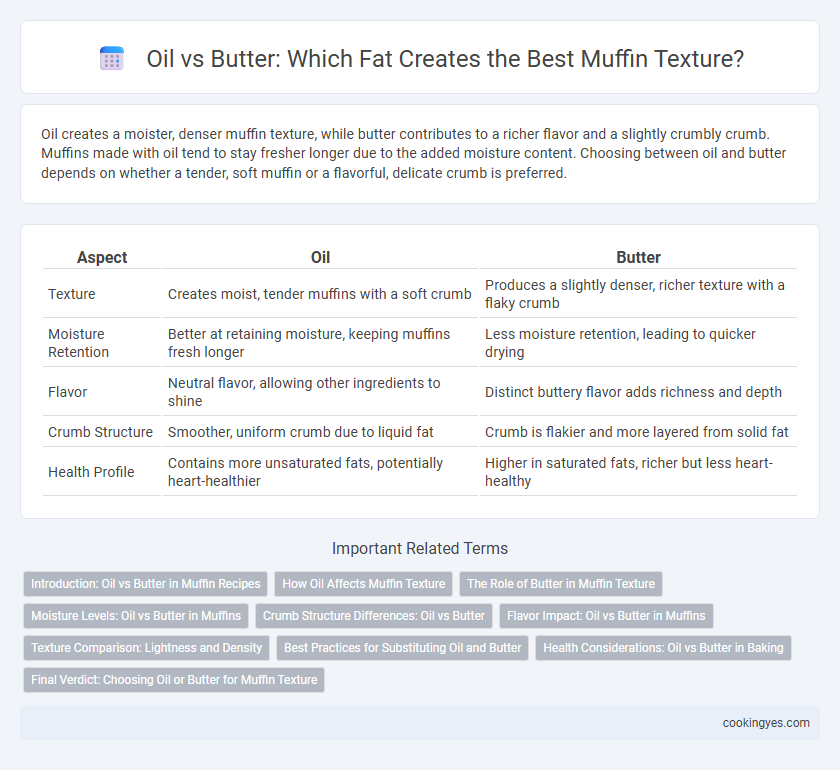Oil creates a moister, denser muffin texture, while butter contributes to a richer flavor and a slightly crumbly crumb. Muffins made with oil tend to stay fresher longer due to the added moisture content. Choosing between oil and butter depends on whether a tender, soft muffin or a flavorful, delicate crumb is preferred.
Table of Comparison
| Aspect | Oil | Butter |
|---|---|---|
| Texture | Creates moist, tender muffins with a soft crumb | Produces a slightly denser, richer texture with a flaky crumb |
| Moisture Retention | Better at retaining moisture, keeping muffins fresh longer | Less moisture retention, leading to quicker drying |
| Flavor | Neutral flavor, allowing other ingredients to shine | Distinct buttery flavor adds richness and depth |
| Crumb Structure | Smoother, uniform crumb due to liquid fat | Crumb is flakier and more layered from solid fat |
| Health Profile | Contains more unsaturated fats, potentially heart-healthier | Higher in saturated fats, richer but less heart-healthy |
Introduction: Oil vs Butter in Muffin Recipes
Oil in muffin recipes creates a moist, tender crumb by coating flour proteins and limiting gluten formation, resulting in a softer texture. Butter contributes to a richer flavor and firmer structure due to its water content and ability to aerate batter when creamed. Choosing oil yields lighter, denser muffins while butter offers depth and a slight crispness to the crust.
How Oil Affects Muffin Texture
Oil enhances muffin texture by creating a moister and denser crumb due to its liquid state at room temperature, which coats flour proteins and limits gluten formation. This results in a tender, soft, and rich muffin compared to butter, which solidifies when cool and produces a firmer crust. Oils like vegetable or canola oil contribute to extended freshness by retaining moisture longer than butter-based batters.
The Role of Butter in Muffin Texture
Butter contributes to muffin texture by providing richness and moisture through its fat content, resulting in a tender crumb and enhanced flavor complexity. Its ability to trap air when creamed with sugar aids in creating a light, fluffy muffin structure. The melting point of butter also affects the muffin's crumb, promoting a soft and moist interior compared to the denser texture often achieved with oil.
Moisture Levels: Oil vs Butter in Muffins
Oil contributes to higher moisture levels in muffins due to its liquid state at room temperature, resulting in a tender and moist crumb. Butter, containing water and milk solids, offers a rich flavor but can produce a slightly denser texture with less moisture retention. Choosing oil typically enhances softness and longevity, while butter provides flavor complexity with comparatively reduced moistness.
Crumb Structure Differences: Oil vs Butter
Oil creates a more tender and moist crumb structure in muffins due to its liquid state at room temperature, allowing for better moisture retention and a softer texture. Butter, solid at room temperature, contributes to a firmer crumb with a slightly denser and more structured texture, as its creaming ability traps air that leads to a more defined crumb. The choice between oil and butter directly affects muffin crumb softness, moisture, and overall mouthfeel, with oil yielding fluffier crumbs and butter creating richer, crumbly textures.
Flavor Impact: Oil vs Butter in Muffins
Butter imparts a rich, creamy flavor that enhances the overall taste profile of muffins, providing a slightly caramelized, buttery note. Oil, in contrast, produces a more neutral flavor, allowing other ingredients like fruits or spices to stand out without competing. Choosing butter over oil significantly affects the depth of flavor and mouthfeel, making muffins taste more indulgent and aromatic.
Texture Comparison: Lightness and Density
Butter creates a richer, denser muffin texture due to its solid fat content and ability to trap air when creamed with sugar. Oil produces lighter, moister muffins with a tender crumb because it remains liquid at room temperature, coating flour proteins and preventing gluten formation. Choosing between butter and oil depends on desired texture: butter for a firm, buttery crumb and oil for a soft, delicate muffin.
Best Practices for Substituting Oil and Butter
Using oil in muffins typically results in a moister and denser texture, while butter provides a richer flavor and a slightly firmer crumb. For best results when substituting, use about 3/4 the amount of butter for oil to account for butter's water content and cream the butter to incorporate air, enhancing muffin rise. Maintaining proper mixing techniques and adjusting baking times can ensure optimal texture regardless of the fat choice.
Health Considerations: Oil vs Butter in Baking
Choosing oil over butter in muffin recipes can boost moisture retention and create a tender crumb due to oil's liquid state at room temperature, but butter adds rich flavor and contributes to a slightly denser texture. From a health perspective, oils with unsaturated fats, such as canola or olive oil, offer heart health benefits by reducing LDL cholesterol, while butter contains saturated fats linked to higher cholesterol levels. For healthier muffins, using oils rich in monounsaturated and polyunsaturated fats supports improved lipid profiles and better cardiovascular health compared to butter.
Final Verdict: Choosing Oil or Butter for Muffin Texture
Oil creates muffins with a moist, tender crumb due to its liquid consistency, while butter imparts a richer flavor and slightly denser texture because of its solid fat content. Choosing oil results in a lighter, softer muffin ideal for fruity or moist varieties, whereas butter enhances flavor and adds structure, perfect for classic or buttery muffins. For the best balance in muffin texture, many bakers combine both, leveraging oil's moisture retention and butter's flavor depth.
Oil vs Butter for muffin texture Infographic

 cookingyes.com
cookingyes.com